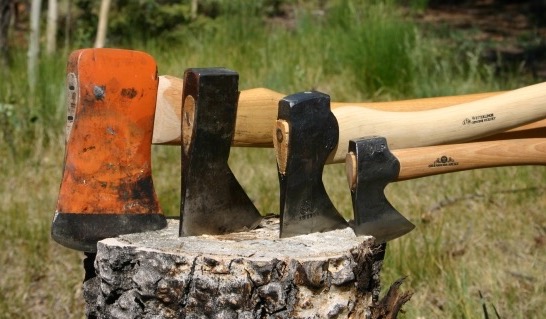Every year that I can make it I go on summer vacation for a week in Colorado in a remote wilderness area, camping, hiking and fishing with old buddies. It is roughly 50 miles off of the nearest paved road. The area we use is a primitive camping area and at 10,000 feet. Temperatures can range from 34 F to 92 F.
I use this time partly to keep up my outdoor skills, practice axe skills, evaluate new camping equipment and ideas, practice alternate fire building skills, and sit around the campfire with the guys telling stories about how fast we used to be. I even catch a trout once in a while.
I am not an axe expert but do like to learn about axe history and use them in the woods. On these trips, I generally carry my full-size 3-pound head axe, a 2-1/4 pound Collins Legitimus ¾ (or Hudson Bay type) axe, and my old Gränsfors Small Hatchet. I carry all three to Colorado in a hard side rifle case which has worked out well.
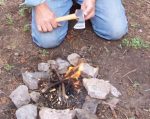 I like using axes as a traditional and useful skill that connects us with the ages and warms you twice. On a side note, axes don’t foul spark plugs or run out of gas. As a long-time axe user I know some of this report may be obvious to experienced axe users, but I still occasionally learn a few new things on these outings. Once in a while I bring a new-to-me axe to test against my three favorites, and have my buddies try them out. This time the new fourth axe was a short handle Wetterling 20H Hunters Axe, one of the few axes along with the Gränsfors mini axe that I have purchased new. All of these axes were used on this trip by cutting the abundant dry deadfall, felling standing dead aspen, cutting kindling, general fire building chores, and making fuzz sticks.
I like using axes as a traditional and useful skill that connects us with the ages and warms you twice. On a side note, axes don’t foul spark plugs or run out of gas. As a long-time axe user I know some of this report may be obvious to experienced axe users, but I still occasionally learn a few new things on these outings. Once in a while I bring a new-to-me axe to test against my three favorites, and have my buddies try them out. This time the new fourth axe was a short handle Wetterling 20H Hunters Axe, one of the few axes along with the Gränsfors mini axe that I have purchased new. All of these axes were used on this trip by cutting the abundant dry deadfall, felling standing dead aspen, cutting kindling, general fire building chores, and making fuzz sticks.
The 3-pound axe was a garage sale find with a bad handle. The axe head is marked “Firestone” but looks very similar to a 3 pound Plumb that I have. I installed a new handle, which has to be done correctly for the axe to perform at its best. It is very sharp but has not been reground.
It is my most used axe and probably shows it. For some reason this 3-pound full-size axe cuts and handles better for me than heavier axes. I feel that it is also safer in some regards since the longer handle tends to keep the head further away from your legs and feet if you should strike a glancing blow and the head skip off the wood. Also both hands are on the axe, where when using a hatchet the off-hand could be vulnerable.
The head was painted orange is an attempt to make the axe more visible in the woods and is done to many of my axes. The actual weight of the entire axe is 73 ounces or roughly 4-½ pounds.
The Firestone axe normally does the bulk of the cutting on these trips. It does not dull noticeably during a week of cutting firewood for the camp. It is generally the fastest and least fatiguing axe to use for cutting and stockpiling firewood. There is a reason that this size of axe has been so popular for so long in many parts of the world. It appears to be the safest axe to use if normal safety precautions are observed.
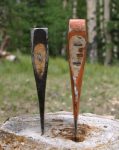 The used Collins Legitimus head was purchased on eBay for a song, was reground by me due to edge damage and fitted with a new handle. The handle is first class and cost more that the head. The axe is of the Hudson Bay or Tomahawk style, light and easy to use. Axes of this size and weight have long been popular with canoe users who go into the wilderness. The weight of the Collins axe is 45 ounces or just over 2 ¾ pounds. This size axe is commonly called a boy’s axe, and is an excellent size for a youngster under proper supervision.
The used Collins Legitimus head was purchased on eBay for a song, was reground by me due to edge damage and fitted with a new handle. The handle is first class and cost more that the head. The axe is of the Hudson Bay or Tomahawk style, light and easy to use. Axes of this size and weight have long been popular with canoe users who go into the wilderness. The weight of the Collins axe is 45 ounces or just over 2 ¾ pounds. This size axe is commonly called a boy’s axe, and is an excellent size for a youngster under proper supervision.
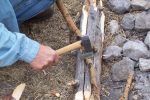 The Gränsfors Small Hatchet (or Mini Hatchet) was bought new. It is the smallest and most expensive axe I have ever bought, but worth the price to me. I polished and resharpened it but did not reprofile it since the profile was perfect from the factory. I have to admit that the high cost of the axe can be a barrier to the occasional user.
The Gränsfors Small Hatchet (or Mini Hatchet) was bought new. It is the smallest and most expensive axe I have ever bought, but worth the price to me. I polished and resharpened it but did not reprofile it since the profile was perfect from the factory. I have to admit that the high cost of the axe can be a barrier to the occasional user.
The distinguishing feature of the Gränsfors is its short handle relative to the size of its head. The handle is stout enough to depend on, which is another reason I like it. It is extremely practical to carry with you in any small pack. It only weighs around 14 ounces. I had already concluded from earlier use that the Gränsfors was far better than a large camp and survival knife for fire building and small brush clearing.
The brand new Wetterling is around 20 inches overall. It can be used with one hand as a big hatchet or with two hands as an axe. I bought one because of the many favorable comments on this axe. The total weight of the Wetterling axe is 33 ounces or just over two pounds. The Wetterling came sharp and looks solid. The quality is excellent and the price is right.
Our normal campsite is surrounded by aspen trees, many of which were dead but still standing. There is always a lot of deadfall. Since a lot of deadfall is cut the cutting effectiveness report is somewhat skewed by the material being cut but is still valuable. Cutting deadfall is a much tougher test of cutting ability and edge holding and is not entirely representative of cutting green or sappy wood.
Various scenarios were used to test the Wetterling. However, as luck would have it, on the first dead tree I felled the handle of my preferred large axe split in two along the length of the handle, something I had not seen before. I noticed the sound and feel changed as I was cutting. The split started at the axe head and worked its way down the handle. The big guy was out of action for the duration of this particular trip.
For the rest of the trip the main firewood chores were handled by the Collins axe. I had not used a ¾ axe this extensively before. A few standing dead aspens were cut down and a few deadfall aspens were cut up with this axe. By the way, dry or dead aspen burns very well and leaves only ash with no appreciable coals. By the end of the week the head had moved up the handle about 1/32 of an inch. I will push it back in place, tap the wedge further in, and add a small steel wedge.
The Gränsfors was used as normal to cut smaller tree limbs and prepare wood used to build several of my small practice fires. Some small diameter wood came from dead limbs still attached to pine trees and dead aspen. The mall diameter pieces were cut into usable lengths. Some of this wood was then split into pencil-sized kindling pieces for fire building. Building the practice fires using various methods took from about five minutes to 30 minutes each start to finish, needing only more wood added once the fire was lit. The Gränsfors was also used to cut a variety of fuzz sticks by choking up on the handle.
On a whim a dead aspen six or seven inches in diameter was cut down solely with the Gränsfors by cutting an ever deepening “V” ring around it until it fell of its own weight. I think the guys put me up to this for entertainment value. This was time-consuming but not difficult. I found that I tended to use muscle power to improve the cutting efficiency of the Gränsfors. Either it is too light at 14 ounces to use only the weight of the head to cut with, or I am too impatient to let it. In any event it did well under the increased force with no loosening of the handle or other ill effects.
My Lessons Learned
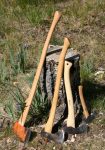 learned a lot from all this. One thing is that had I brought only one axe and it failed it would have been difficult to keep a large supply of firewood stockpiled for the community campfire in case a rainy day prevented firewood gathering. I commonly carry at least two axes in the backwoods but have never really needed the second one until that trip. I am used to the big axe and prefer it for firewood work. When it was taken out of action the ¾ axe was able to do well, although noticeably slower. The Gränsfors mini is perfect for starting and building a fire and was used daily for that purpose. I also carry it on wilderness hikes due to its small size and weight and its great utility.
learned a lot from all this. One thing is that had I brought only one axe and it failed it would have been difficult to keep a large supply of firewood stockpiled for the community campfire in case a rainy day prevented firewood gathering. I commonly carry at least two axes in the backwoods but have never really needed the second one until that trip. I am used to the big axe and prefer it for firewood work. When it was taken out of action the ¾ axe was able to do well, although noticeably slower. The Gränsfors mini is perfect for starting and building a fire and was used daily for that purpose. I also carry it on wilderness hikes due to its small size and weight and its great utility.
Had I taken only the Gränsfors mini I could have built a fire quickly and kept it going indefinitely with two-to-three-inch branches. This would have required more attention to the fire than when using larger firewood and taken a lot more time and effort to keep the wood supply at a comfortable level. Cutting up large trees for wood would have not been worth the effort except possibly as a backing reflector.
So the failure of my favorite axe made me pay more attention to my wood cutting needs and more closely examine the best use for each size and length of axe. My bias for the big axe seems to be validated by how much I missed its usefulness on the trip. For me, the full-size axe is the best when you need to cut (or split) a lot of wood. The ¾ axe is a very viable tool for cutting lots of wood, significantly better than a hatchet or small axe but not completely on par with the large axe. And the Gränsfors will get you by in the real woods, although more effort is required.
Of the three the Gränsfors is the one I am most likely to have with me on a day hike or when backpacking. The Gränsfors axe is a great light axe and is best as a small axe that you will always have with you. The Gränsfors did all small jobs well and can be used to cut larger trees if needed. The handle is stout enough to depend on. It is very good for fire building and clearing small brush at a campsite.
The Collins axe held up well and excels as an excellent usable axe that is significantly smaller and lighter than the normal full-size axe. It does many things splendidly but requires more effort to cut a volume of wood than the full-size axe. It can be used as a hatchet by choking up on the handle. It would be my first choice for backpacking if I knew I would be clearing or improving trails as I went.
The Wetterling axe is best as a hatchet for an experienced user. It was used for building and maintaining small fires and cut smaller diameter wood quickly. A six inch diameter standing dead aspen was cut down fairly quickly with this axe. Its added weight lets it cut better than the Gränsfors.
However, I found that for me, the Wetterling axe is neither fish nor fowl. While made of first-class materials, it is too heavy for a backpacking or carry axe that you will always have with you and not versatile enough as an all-around using axe to overlook the added weight. It is somewhat clumsy as a two-handed axe and does not cut as well as either of the larger axes. I found it fatiguing to use for any length of time. The weight advantage over the Collins axe is not as important to me as the very superior handling and cutting ability of the Collins, which I attribute to the longer handle on the Collins. It is much heavier than the Gränsfors. Please bear in mind that a lot of people use this axe or others like it and my observations are how I personally see its use. It is probably fair to say that due to my outdoor experiences I favor the larger axes.
Edges on all the axes held up well. There was a slight rolling of the edge on the Collins axe after extensive use, easily removed with a stone.
On the way out of the campsite two downed green aspens had blown over and blocked the primitive road in different places. These trees were removed from the road in a matter of minutes with the Collins axe. The difference in cutting in green wood and old deadfall is amazing.
In summary, I believe that there are two main scenarios for those that choose to carry an axe into the woods based on the size of the axe. The first scenario is the axe user that knows what tasks the axe will perform and chooses the axe based on the tasks and the travel method. Usage and the travel method (backpacking, packing in with horses, canoeing, motor vehicle travel, etc.) tend to point to a relationship between the weight of the axe and the foreseen use. This will vary by individual and trip by trip. If bulk or weight was an issue I would take the Collins and the Gränsfors.
The second scenario is the outdoorsman that may have an undefined, general need for an axe due to some kind of unforeseen circumstance. The Gränsfors is the obvious choice here for backpacking due to its diminutive size and weight. Those going for an extended foray into the real wilderness such as hunters might include a larger axe like the Collins as a primary axe or as a backup to something like a folding handsaw.
As with all cutting tools read up and learn axe and hatched safety before you use the tools and practice under an experienced person if possible. Learn how to safely sharpen and maintain these tools. The backwoods is not a good place to have an accident with an axe.
I hope this admittedly subjective and rambling axe discussion helps those looking for axe information.

